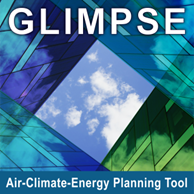GLIMPSE – Modeling Tool for State Environmental and Energy Planning
Published September 21, 2023

Many different systems—including the economy, public health, energy supply and demand, climate, and the environment —are interacting with one another at both local and global scales all the time. A change in one system may impact another—sometimes in unexpected ways—resulting in a complex decision-making environment. EPA created the GLIMPSE modeling tool to help decision-makers navigate these complexities, understand tradeoffs across management objectives, and ultimately design more effective policies.
What is GLIMPSE?
The GCAM Long-term Interactive Multi-Pollutant Scenario Evaluator (GLIMPSE) is a modeling tool that helps states explore the impacts of energy technologies and policies on the environment. The software can be used by policy analysts, energy and environmental planners, and faculty and students.
GLIMPSE is the graphical user interface for the Global Change Analysis Model (GCAM) – an open source, publicly available model that integrates the ways people interact with each other, technology, and the environment. GCAM simulates the complex interactions between five major systems – energy, water, land, climate, and the economy – at global and regional scales. The model helps answer “what if” questions, how the future will evolve under a particular set of conditions, and how the system will change under the influence of external factors. Users can also explore how changes in one region could affect other regions and compare multiple scenarios. GLIMPSE’s Scenario Builder facilitates setting up and running GCAM, monitoring progress, and diagnosing issues. The Results Viewer helps users visualize results and highlights outputs that change the most from one scenario to another.
For a given scenario, GLIMPSE estimates what technologies will be adopted and when. The model tracks fuel use and prices, including how a scenario impacts the costs of heating homes and daily travel. Environmental outputs include greenhouse gas emissions, change in global mean temperature, air pollutant emissions, and water use.
One application of GLIMPSE is to assess the impacts of new and emerging technologies. For example, GLIMPSE has been used to evaluate an electric vehicle sales target, estimate gasoline savings and additional electricity demand, and determine how that electricity could be produced. GLIMPSE tracks greenhouse gas and air pollutant emissions across these activities, producing an estimate of the net benefits of the sales target.
In another application, users can specify energy, air quality, and water use goals. The model then identifies cost-effective strategies for meeting those goals. For example, states could use GLIMPSE to develop air quality management strategies that also meet renewable electricity targets and energy security objectives, and factor in how droughts could affect power plant operations.
What are the benefits of GLIMPSE?
User-Friendly: Users can specify complex technology or policy scenarios in minutes.
Fast: Once a scenario is specified, model results are available within hours on a typical Windows computer (16 GB of RAM and 60 GB of free hard disk space are required).
Flexible: Many assumptions can be changed, including population growth, economic growth, and technology costs and availability. Policies that can be simulated include technology subsidies, clean energy standards, vehicle electrification targets, and emission caps.
Transparent: The GCAM model and data are open source and freely available.
Comprehensive: GLIMPSE can identify important unintended consequences and other policy considerations that may not otherwise be apparent.
Multi-scale: Users can specify policies or examine energy technologies at the global, national, regional, and state levels.
Multi-sector: GLIMPSE simulates technology adoption, fuel use, and emissions across multiple sectors, including electricity production, refining, manufacturing, agriculture, buildings, and transportation.
Multi-pollutant: GLIMPSE includes both greenhouse gas and air pollutant emissions.
For more information about GLIMPSE, visit epa.gov/glimpse or contact Dan Loughlin, [email protected] or Chris Nolte, [email protected].
